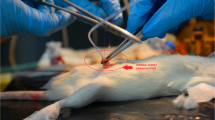Summary
The effect of different types of textile fabric on spermatogenesis was studied. Twenty-four dogs were divided into two equal groups, one of which wore cotton underpants and the other polyester ones. Seven dogs wearing nothing were used as controls. The underwear was fashioned to fit loosely in the scrotal area so as to avoid its insulating effect. It was worn continuously for 24 months during which the semen character, testicular temperature, hormones (serum testosterone, follicle stimulating hormone, luteinizing hormone, prolactin) and testicular biopsy were examined. The garment was then removed, and the same investigations repeated through another 12 months. The results were analysed statistically. In the polyester group the testicular temperature showed insignificant changes during the period when the pants were worn (P>0.05). By the end of the 24 months there was a significant decrease in sperm count and motile sperms, with an increase in abnormal forms (P<0.001); the testicular biopsy showed degenerative changes. After garment removal the semen character improved gradually to normal in 10 dogs; two remained oligozoospermic. There were insignificant changes (P>0.05) in hormones during the study. In contrast, the cotton and control groups showed insignificant changes (P>0.05) in all the study. The polyester pants thus had a deleterious effect on spermatogenesis in the dogs which was, however, reversible in the majority of cases. The cause of this effect is unknown, but it may be assumed that the electrostatic potentials generated by the polyester fabric play a role in it.
Similar content being viewed by others
References
Barron CL, Baroff AA (1958) Medical considerations of exposure to microwave (radar). JAMA 168:1194
Boyar RM, Finkelstein JW, Witkin M, Kapen S, Weitzman E, Hellman L (1973) Studies of endocrine function in “isolated gonadotropin deficiency”. J Clin Endocrinol Metab 36:64
Cowden E (1979) Laboratory assessment of prolactin status. Ann Clin Biochem 16:155
Dumontier A, Burdick A, Ewigman B, Fahim MS (1977) Effects of sonication on mature rat testes. Fertil Steril 28:195
Fahim MS, Fahim Z, Harman J, Thompson I, Montie J, Hall DG (1977) Ultrasound as a new method of male contraception. Fertil Steril 28:823
Lazarus BA, Zorgniotti AW (1975) Thermoregulation of the human testis. Fertil Steril 26:757
Mieusset R, Bujan L, Mondinat C, Mansat A, Pontonnier F, Grandjean H (1987) Association of scrotal hypothermia with impaired spermatogenesis in infertile men. Fertil Steril 48:1006
Moseley H (1988) Non-ionizing radiation: microwaves, ultraviolet and laser radiation, Hilger, Bristol
O'Brien WD, Brady JK, Dunn F (1979) Morphologic changes to mouse from in vivo ultrasonic irradiation. Ultrasound Med Biol 5:35
Pont, A, Shelton R, Odell WD (1979) Prolactin secreting tumors in men: surgical cure. Ann Intern Med 91:211
Rabin D, Spitz I, Berrovici B, Bell J, Laufer A, Benveniste R, Polishuk W (1972) Isolated deficiency of follicle-stimulating hormone. N Engl J Med 287:1313
Rosenthal DS, Beering SC (1968) Hypogonadism after microwave radiation. JAMA 205:245
Santner S, Sanlen R, Kulin H, Dewers L (1981) A model for validation of radioimmunoassay kit reagents: measurement of follitropin and leutropin in blood and urine. Clin Chem 27:1892
Shafik A (1978) Absent dartos. Br J Urol 50:354
Shafik A (1991) The physiology of testicular thermoregulation in the light of new anatomical and pathological aspects. Adv Exp Med Biol 286:153
Shafik A, Olfat S (1979) Aligamentous testicle: new clinocopatholgic entity in genesis of male infertility and its treatment by orchiopexy. Urology 13:54
Shafik A, Olfat S (1981) Scrotal lipomatosis. Br J Urol 53:50
Shafik A, Ibrahim IH, El-Sayed EM (1992) Effect of different types of textile fabric on spermatogenesis. I. Electrostatic potentials generated on surface of human scrotum by wearing different types of fabric. Andrologia 24:145
Smith KD, Rodriquez-Rigua L (1979) Laboratory evaluation of testicular function. In: Groot LJ de, Cahill GF, Odell WD et al. (eds) Endocrinology. Grune & Stratton, New York, p 1539
Zorgniotti AW, Maclead J (1973) Studies in temperature, human semen quality and varicocele. Fertil Steril 24:854
Author information
Authors and Affiliations
Rights and permissions
About this article
Cite this article
Shafik, A. Effect of different types of textile fabric on spermatogenesis: an experimental study. Urol. Res. 21, 367–370 (1993). https://doi.org/10.1007/BF00296839
Received:
Accepted:
Issue Date:
DOI: https://doi.org/10.1007/BF00296839




